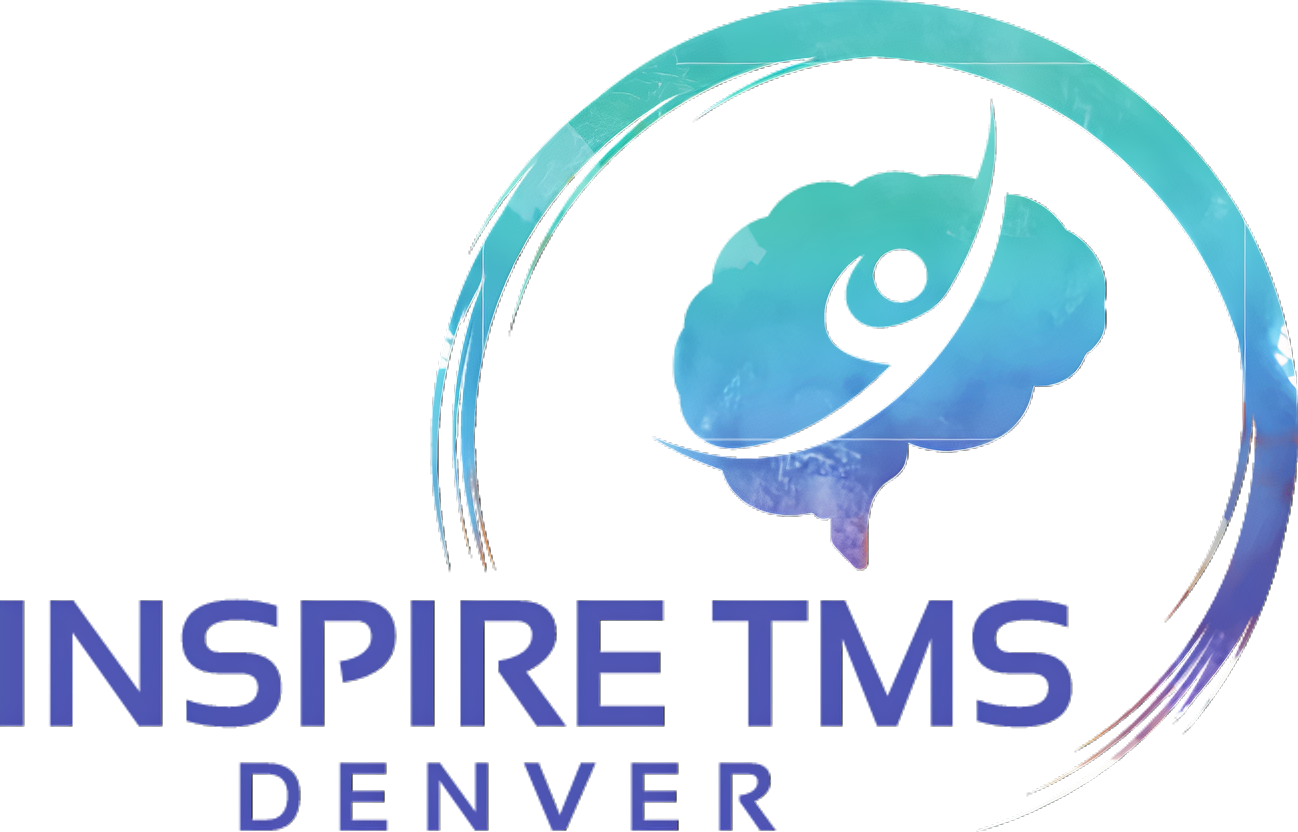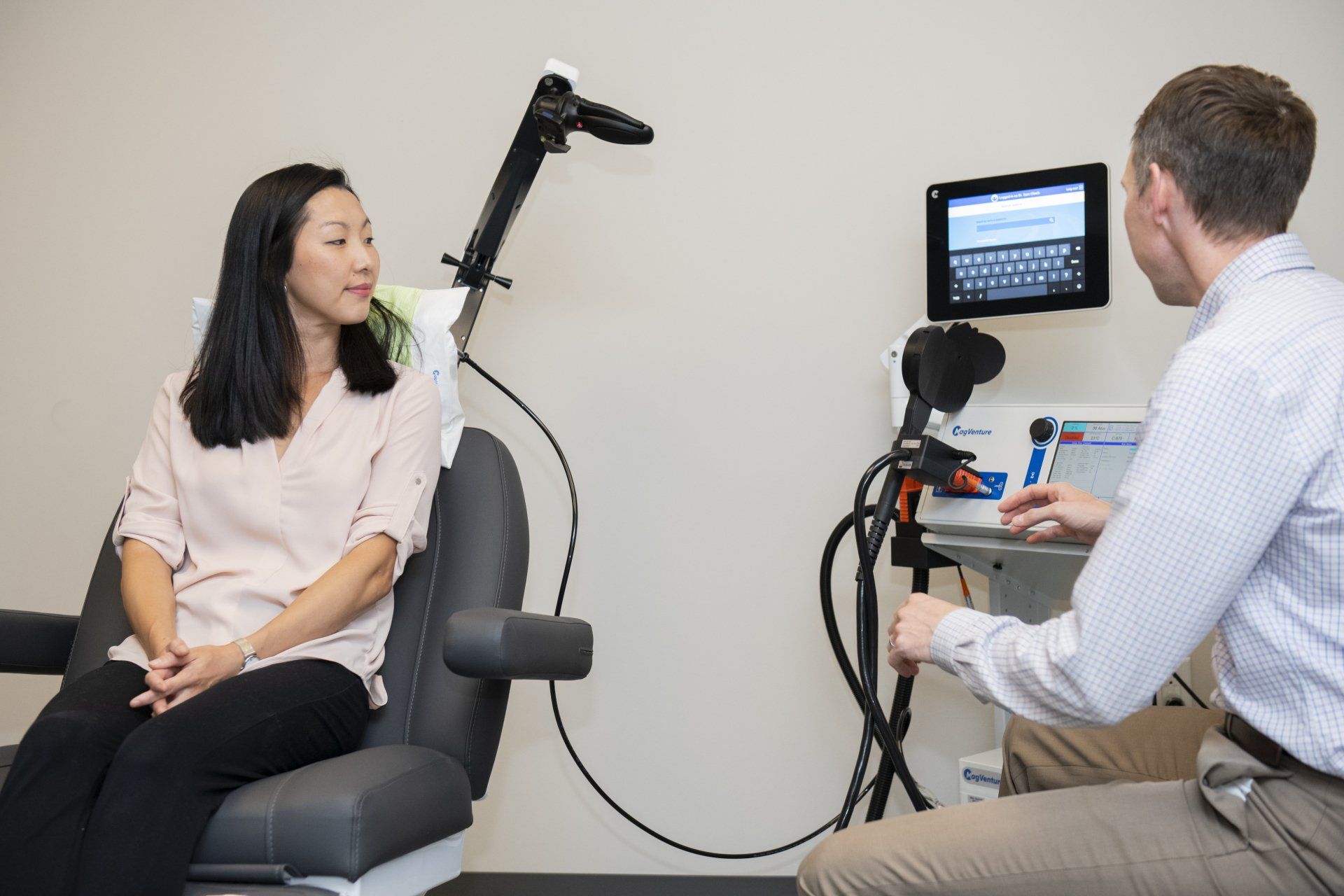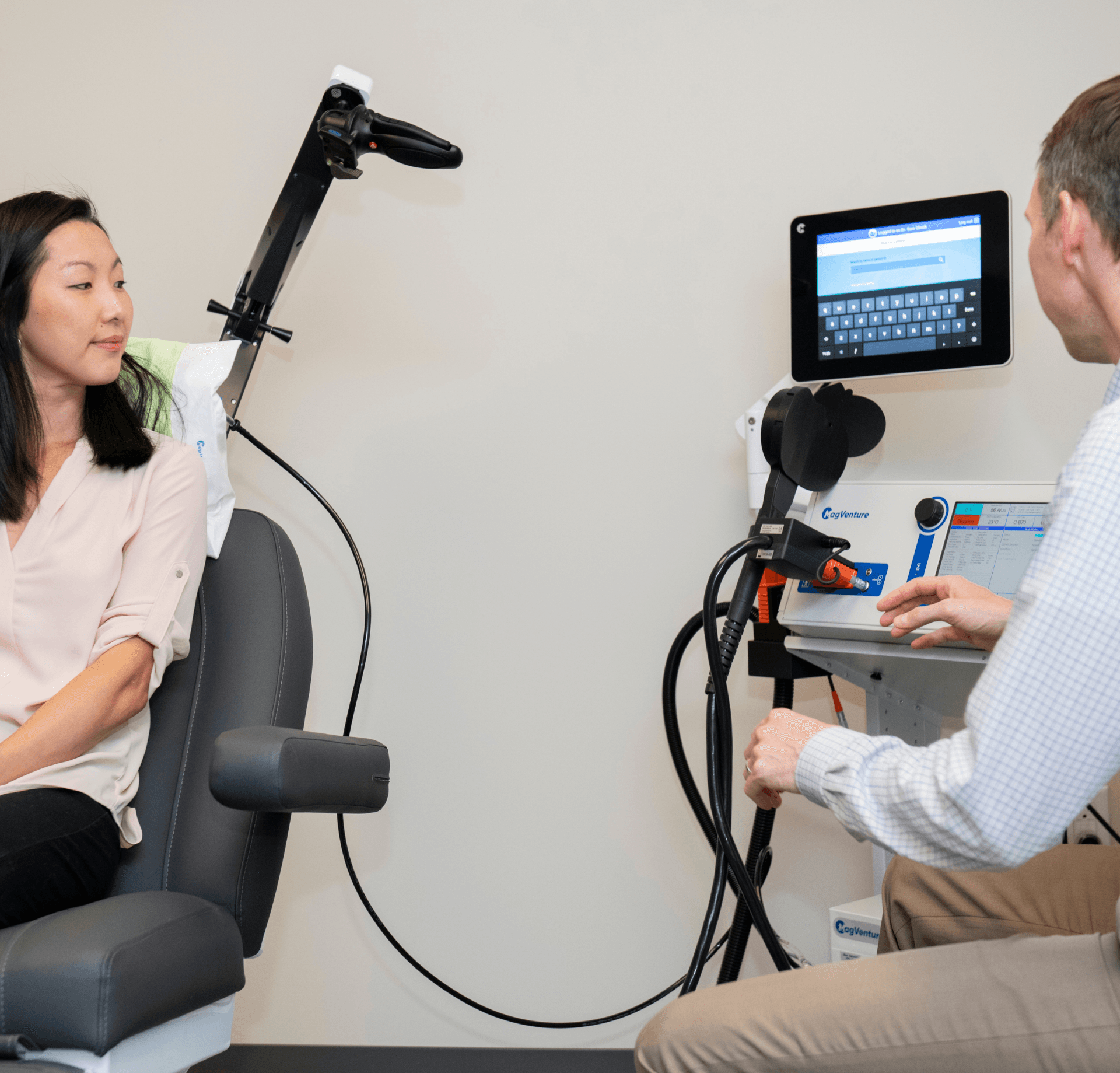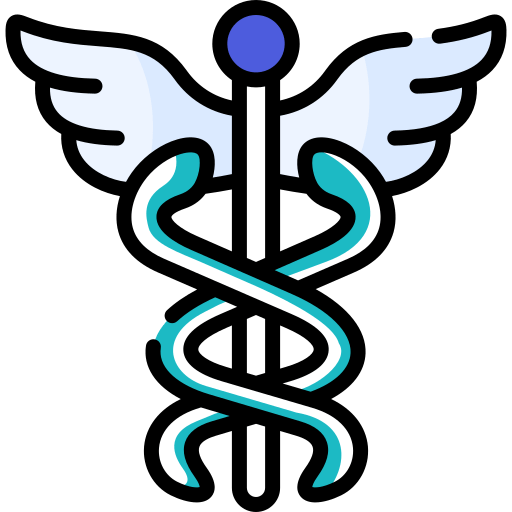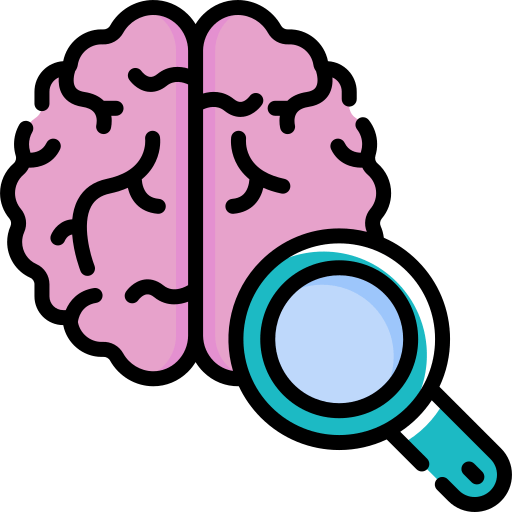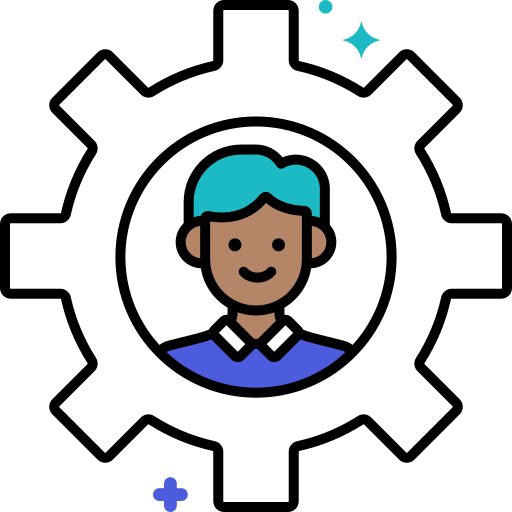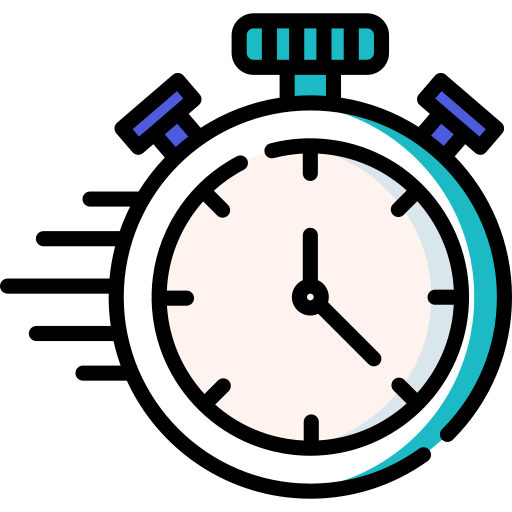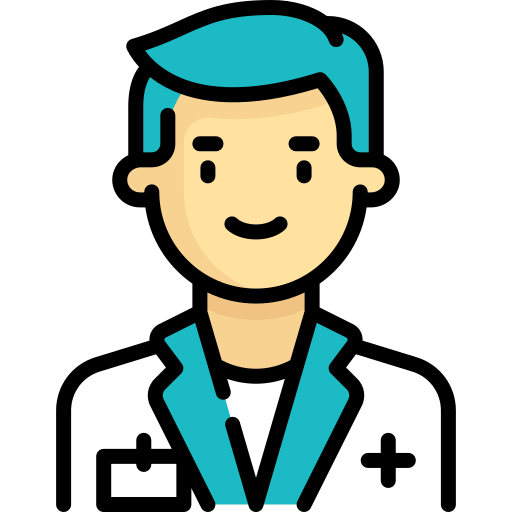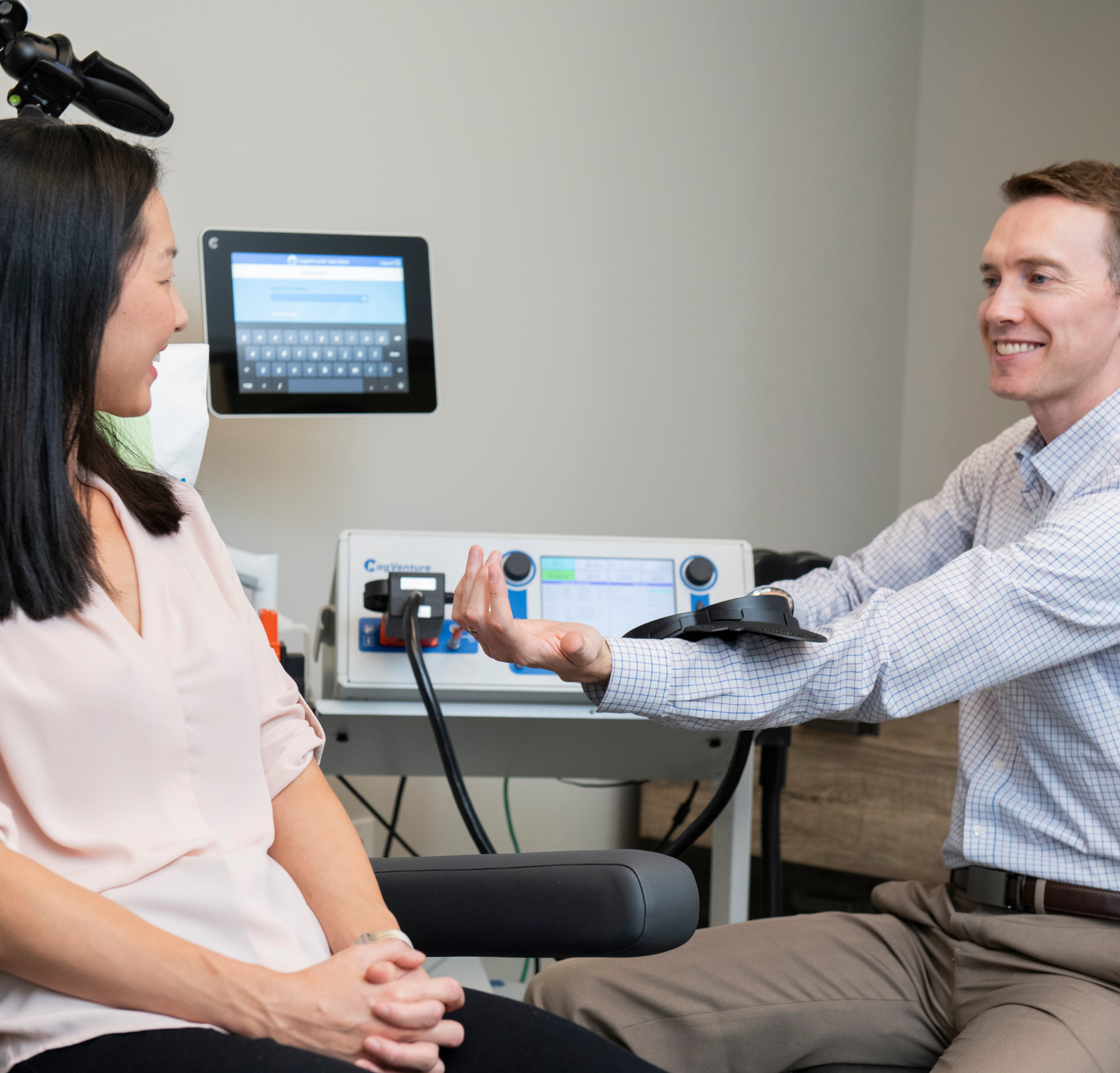LOCATION
340 East 1st Avenue, Suite 333 Broomfield, CO 80020
PHONE
720-446-8675
BUSINESS HOURS
- Mon - Fri
- -
- Sat - Sun
- Closed
Response Rates
10,000+ Treatments Completed
TMS Therapy For Anxiety
Anxiety often co-occurs with depression. Many studies have been done using TMS to treat both. TMS can treat both conditions within 4-6 weeks.
TMS Therapy For Anxiety
Anxiety often co-occurs with depression. Many studies have been done using TMS to treat both. TMS can treat both conditions within 4-6 weeks.
“I highly recommend TMS, Dr Clinch, and everyone on staff to everyone suffering with depression and anxiety. I absolutely know my brain is working differently. I can see myself again. I am no longer stuck with the seemingly never ending depression, anxiety, fear and being unable to function normally...."
“I highly recommend TMS, Dr Clinch, and everyone on staff to everyone suffering with depression and anxiety. I absolutely know my brain is working differently. I can see myself again. I am no longer stuck with the seemingly never ending depression, anxiety, fear and being unable to function normally...."
Treatments for Anxiety Disorders
We have come a long way in treating Anxiety Disorders, but treatment has become more stagnant in the most recent decades. As with depression and other mental health conditions, medication and therapy remain the mainstay for treatment. Similar to depression, however, these treatments only prove effective for some and side effects commonly occur with medication use. And when you add up all the anxiety disorders, they actually affect more people than depression.
Read more:
TMS vs medication →
In light of this, TMS is being researched as an effective treatment for many anxiety disorders. A number of studies are smaller in size compared to those for Major Depression treatment, but the evidence base is growing in recent years. As of 2018, Brainsway and
Magventure have obtained FDA approval for the treatment of OCD. There are a number of positive studies supporting TMS use for Generalized Anxiety and PTSD as well or for treating Anxious Depression. There are separate pages devoted to OCD and PTSD treatment, so we will spend time here focusing on Generalized Anxiety Disorder-GAD.
Can TMS Worsen Anxiety?
Early in treatment, anxiety can infrequently increase with treatment. This is usually mild and temporary and can actually be an indication that treatment is working. Lowering treatment intensity, taking titration of intensity more slowly, or adding in additional protocols can help mitigate anxiety should this occur. Any anxiety typically resolves in time even without any adjustment to protocol. There is good evidence supporting TMS as an effective treatment for anxiety and we have experienced similar improvements in anxiety symptoms along with depressive symptom improvement. TMS does also have FDA approval for treating OCD, which is an anxiety spectrum disorder itself.
TMS Treatment for Generalized Anxiety In Denver
As noted, there are a number of very positive studies when it comes to treatment of GAD with TMS.² The best studies have shown response (partial benefit) in 80-100% of patients and remission (complete resolution) in 33% to 85% of patients. These are very strong numbers. Most of the treatments for GAD focus on right-sided targets for treatment location and often use a lower frequency treatment aimed at decreasing hyperactive brain loops. Most other aspects of treatment remain the same as with
TMS therapy for depression, however.
As with TMS for depression, there are no systemic side effects and the treatment is safe and typically well-tolerated. The procedure still harnesses magnetic waves to influence the electrical connections in the areas of the brain that are responsible for anxiety symptoms. One way to conceptualize treatments is similar to cognitive behavioral therapy for anxiety - CBT. In CBT you are slowly reshaping maladaptive patterns of thinking and/or behavior that contribute to depression or anxiety. Similarly, in TMS, we are rewiring these pathways, but at a much faster means and rate and with indirect electrical stimulation. TMS represents a unique and medication-free means for addressing anxiety. Anxiety relief can typically occur in four to six weeks with TMS therapy.
As described above, only TMS for OCD is currently approved by the FDA. Off-label treatment can be pursued for other anxiety symptoms and these conditions often co-occur with Major Depressive Disorder, however, in some 50% of individuals. Inspire TMS Denver does not charge for add-on treatments when this occurs and offers competitive pricing when self-pay may be pursued for anxiety management alone. At Inspire TMS Denver we always tailor treatment according to individual patient needs. More questions about TMS Therapy for Anxiety or other information on this page? Contact us here to see about a free phone consultation.
Don't Worry, Be Happy
The clinical definition of anxiety by the Encyclopedia of Mental disorders is summarized below,
‘Anxiety is an unpleasant emotion triggered by anticipation of future events, memories of past events, or ruminations about the self’.
Anxiety can present in many different ways. Some anxiety sufferers appreciate more worry and repetitive thinking about stressors or events, while others may appreciate a more physical sensation such as an upset stomach or a racing heart.
Although typically viewed as an undesired emotion, anxiety or fear is not all bad and can help drive behavior in a positive manner.
Healthy Fear Keeps Us Alive
Fear serves to activate our brain into an immediate survival reaction, flooding the body with adrenaline and cortisol in preparation for fight or flight mode. This may be appropriate in times of danger. Less severe anxiety such as that which we feel before a test or a job interview may drive us to study more or spend time preparing for the interview. Without this anxiety, we might be less likely to take action.
Unhealthy Fear
When the brain mistakenly perceives fear everywhere and all the time, however, the body is kept in a heightened state of vigilance. Further, the maladaptive neural connections do not signal the end of any threat and keep the body in a state of high alert. When anxious thoughts are repeated, they strengthen the dysfunctional neural pathways and increase even more anxious thoughts. The brain becomes out of calibration, adopting and reinforcing the new, dysfunctional pathway.
It is at this point that anxiety becomes a disorder and is often found hand in hand with depression and/or other mental health disorders
It affects daily life, relationships, and work; as well as prevents natural adaptation to unfamiliar situations, such as starting a new job. As all can attest to, life is always changing. If your mechanism for accommodating to change becomes a constant state of anxiety, this becomes insurmountable. Small stressors and changes in day-to-day life become overwhelming.
-
Anxiety symptoms can then to lead to:
- Depression
- Insomnia
- Headaches
- Stomach issues or IBS
- Shortness of breath
- Muscle aches
- Teeth grinding
- Changes to appetite
- Loss of libido
Anxiety Disorders
There are many disorders in which anxiety is the predominate driver and below are some of the more common conditions:
Generalized Anxiety Disorder-GAD
GAD affects over 3% of American adults and is often diagnosed with Major Depression Disorder MDD or other anxiety conditions.¹
-
Typical symptoms include:
- Incessant anxiety over several issues
- Over analyzing worst-case scenarios
- Interpreting every situation as threatening
- Struggling with unpredictability
- Intense fear of decision making
- Fear of worry itself
- Agitation/irritability
- Lack of concentration
- Physical fatigue
- Insomnia
- Tense muscles
- Shaking or trembling
- Perspiration
- IBS-irritable bowel syndrome or other stomach problems
Panic Disorder-PD
Disabling panic attacks can invade the mind and body without any apparent trigger, but often occur in certain settings. In an effort to avoid attacks, sufferers begin to change their normal activities, which then only then reinforces the fear, increasing the probability of an attack, and a classic 'catch-22' cycle. Panic attacks are very frightening and can feel as if you are having a heart attack or dying.
-
Panic attacks involve intense fear coupled with:
- Increased pulse rate
- Difficulty breathing
- Tightening in the chest
- Feeling sick and light-headed
- Shaking or trembling
- Feeling hot or cold
- A feeling of choking
- Dizziness
It also displays many of the same symptoms as GAD and affects close to 3% of US adults. Again, Panic Disorder tends to co-occur with other disorders such as Social Anxiety Disorder and Major Depression.
Social Anxiety Disorder-SAD
Social Anxiety Disorder affects almost 15 million Americans, or some 7% of the population, causing extreme distress in social settings. Fear of being judged, of not being physically or intellectually good enough, or acute embarrassment, can activate symptoms of, or even trigger, a full-blown panic attack. Sufferers typically then avoid any social situations, even shopping or going to work. Again, avoidance adds to the fear and becomes self-perpetuating and increases vulnerability to depression and other physical and mental disorders.
Posttraumatic Stress Disorder-PTSD
Another disorder often described along the anxiety spectrum is Posttraumatic Stress Disorder (PTSD). PTSD affects some 3.5% or more of the US adult population each year. PTSD is recognized commonly amongst veterans but can also be caused by a wide variety of events such as assault, accidents, or childhood or domestic abuse.
It can also occur in secondary victims close to murder and rape victims. The strongest indicator for the development of PTSD is the occurrence of childhood sexual abuse and is often labeled as Complex PTSD.
Learn more about TMS for PTSD specifically here.
Obsessive Compulsive Disorder-OCD
Obsessive Compulsive Disorder impacts a lower percentage of individuals compared to the above conditions, but is quite disabling for those who suffer with the condition. Approximately 1%, or over 2 million US adults, struggle with OCD each year. OCD tends to present early in life with ¼ of cases appearing by age 14 and an average age of onset of 19.
As the condition suggests, the mind becomes obsessive about specific subjects, experiencing repetitive thoughts and mental images that trigger anxiety or disgust.
-
Examples of Obsessions:
- Fear of contamination.
- Perturbing sexual images or thoughts.
- Fear of social embarrassment.
- Fastidious attention to symmetry and order.
- Persistent and invasive mental sounds, numbers, images, or words.
- Fear of misplacing or disposing of something perceived to be important to personal safety.
Obsessions then trigger compulsive behaviors that are perceived to mitigate the perceived fear. Practicing ‘rituals’ gains short-term relief from anxiety but reinforces a self-perpetuating cycle.
Read more: TMS therapy for OCD →
-
Examples of compulsions:
- Extreme cleansing rituals.
- Excessive and irrational preoccupation with household cleanliness.
- Positioning and aligning things in a specific order.
- Relentlessly monitoring locks, appliances, or switches.
- Constant need for reassurance and approval.
- Repetitive counting.


Slide title
Write your caption hereButton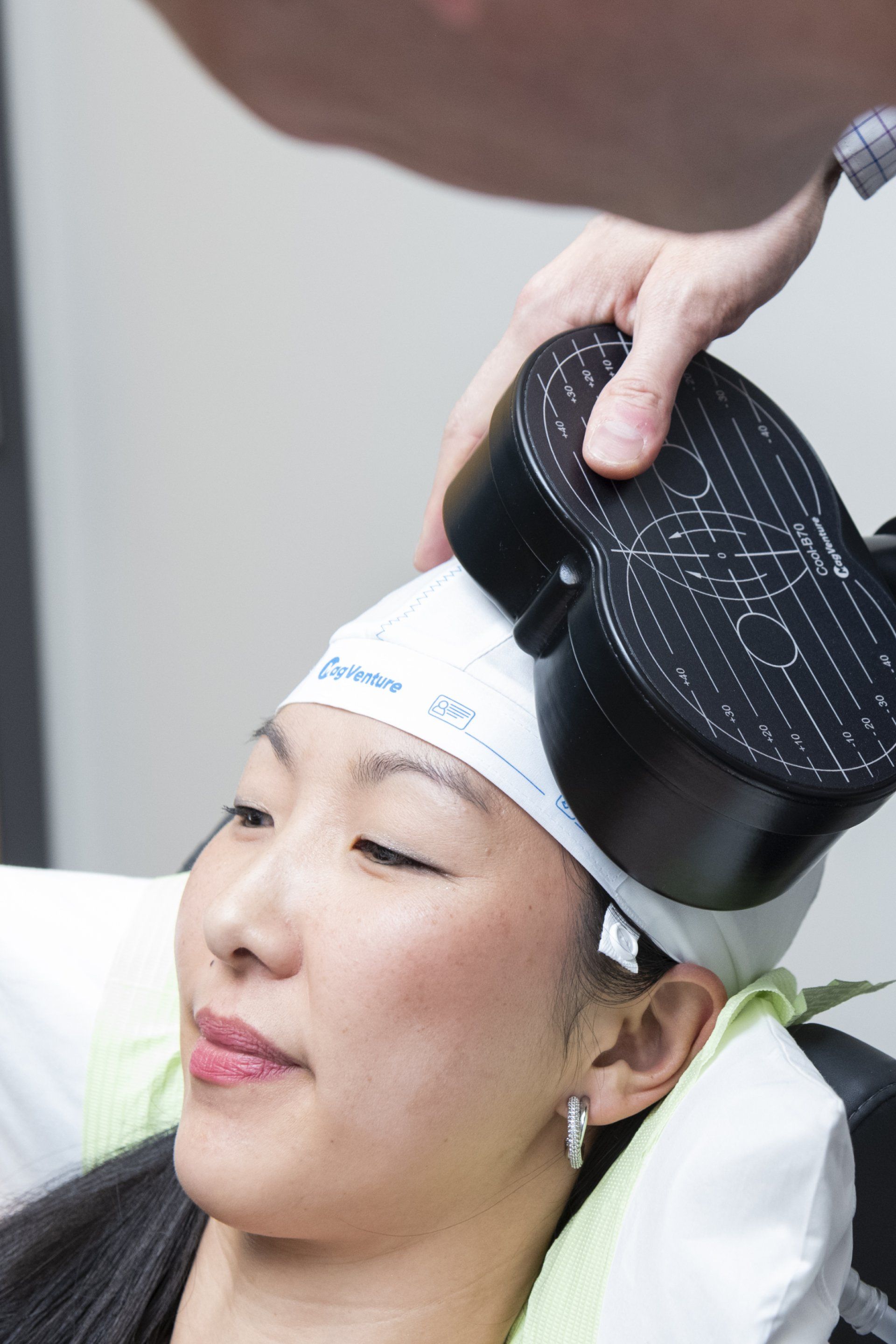
Slide title
Write your caption hereButton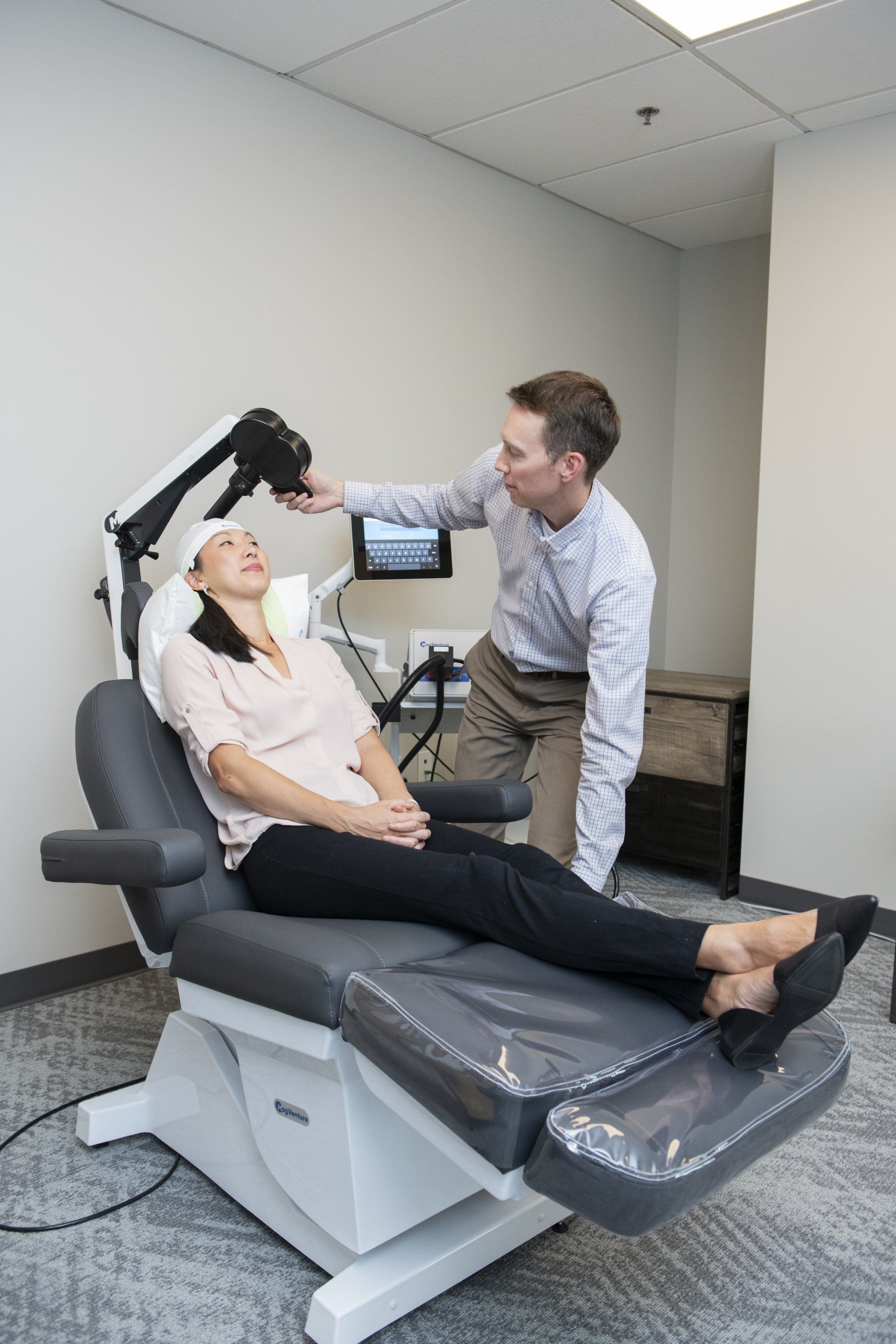
Slide title
Write your caption hereButton
What Makes Us Different

As Seen On Colorado's Best

For more visit our video library →
Awards & Accreditations
This is a paragraph. Writing in paragraphs lets visitors find what they are looking for quickly and easily.
This is a paragraph. Writing in paragraphs lets visitors find what they are looking for quickly and easily.
This is a paragraph. Writing in paragraphs lets visitors find what they are looking for quickly and easily.
This is a paragraph. Writing in paragraphs lets visitors find what they are looking for quickly and easily.
This is a paragraph. Writing in paragraphs lets visitors find what they are looking for quickly and easily.
Company Name
This is a paragraph. Writing in paragraphs lets visitors find what they are looking for quickly and easily.
This is a paragraph. Writing in paragraphs lets visitors find what they are looking for quickly and easily.
This is a paragraph. Writing in paragraphs lets visitors find what they are looking for quickly and easily.
This is a paragraph. Writing in paragraphs lets visitors find what they are looking for quickly and easily.
This is a paragraph. Writing in paragraphs lets visitors find what they are looking for quickly and easily.
Company Name
the tms journey
A Step By Step Process
Book your free telephone consultation with Dr. Clinch and use this time to ask any questions or voice any concerns about TMS. If there are no contraindications to treatment, you are a good candidate, and you wish to proceed with a full evaluation, we will schedule a full intake. You will be sent an invite to our confidential patient portal and forms for review and completion that expedite care.
Shortly after this, you will be seen in person for the full TMS evaluation. This will provide adequate information for us to then submit prior authorization for TMS coverage to your insurer. If seeking care off-label through self-pay, prior authorization is not needed. We then schedule your first and all subsequent treatment sessions. We obtain prior authorization and inform you of all costs prior to starting care.
Come in for your first treatment which starts with a 'mapping' to establish your unique treatment intensity and location. Following this and at all subsequent sessions, you will recline in a motorized chair, similar to a dental visit. You can then relax, listen to music, watch TV, read or chat during the treatment. At the end of your sessions, you can drive and return to your day as normal.
Our shared inspiration is to alleviate mental illness and improve the mental wellbeing of the patients we treat. We respect all backgrounds and cultures and want to hear our patient’s stories to best guide care. During treatment, we reinforce positive wellness practices, help maximize lifestyle modifications, and integrate rTMS therapy into a patient’s overall mental and physical health treatment.
Samuel B. Clinch, M.D
Medical Director
Free Consultation
Call 720-446-8675 now, or complete the form below to request a call back.
Contact Us
We will get back to you as soon as possible.
Please try again later.
Contact Us
LOCATION
340 East 1st Avenue, Suite 333
Broomfield, CO 80020
What Happens After I Send My Message?
A member of our team will confirm your free consultation appointment within one business day.
Discover if TMS is right for you and answer all your queries about treatment, eligibility and costs.
Take the First Step Towards Your Mental Well-being Today
Treatments for Anxiety Disorders
We have come a long way in treating Anxiety Disorders, but treatment has become more stagnant in the most recent decades. As with depression and other mental health conditions, medication and therapy remain the mainstay for treatment. Similar to depression, however, these treatments only prove effective for some and side effects commonly occur with medication use. And when you add up all the anxiety disorders, they actually affect more people than depression.
Read more:
TMS vs medication →
In light of this, TMS is being researched as an effective treatment for many anxiety disorders. A number of studies are smaller in size compared to those for Major Depression treatment, but the evidence base is growing in recent years. As of 2018, Brainsway and
Magventure have obtained FDA approval for the treatment of OCD. There are a number of positive studies supporting TMS use for Generalized Anxiety and PTSD as well or for treating Anxious Depression. There are separate pages devoted to OCD and PTSD treatment, so we will spend time here focusing on Generalized Anxiety Disorder-GAD.
Can TMS Worsen Anxiety?
Early in treatment, anxiety can infrequently increase with treatment. This is usually mild and temporary and can actually be an indication that treatment is working. Lowering treatment intensity, taking titration of intensity more slowly, or adding in additional protocols can help mitigate anxiety should this occur. Any anxiety typically resolves in time even without any adjustment to protocol. There is good evidence supporting TMS as an effective treatment for anxiety and we have experienced similar improvements in anxiety symptoms along with depressive symptom improvement. TMS does also have FDA approval for treating OCD, which is an anxiety spectrum disorder itself.
TMS Treatment for Generalized Anxiety In Denver
As noted, there are a number of very positive studies when it comes to treatment of GAD with TMS.² The best studies have shown response (partial benefit) in 80-100% of patients and remission (complete resolution) in 33% to 85% of patients. These are very strong numbers. Most of the treatments for GAD focus on right-sided targets for treatment location and often use a lower frequency treatment aimed at decreasing hyperactive brain loops. Most other aspects of treatment remain the same as with TMS therapy for depression, however.
View our clinic's
TMS anxiety success rates →
As with TMS for depression, there are no systemic side effects and the treatment is safe and typically well-tolerated. The procedure still harnesses magnetic waves to influence the electrical connections in the areas of the brain that are responsible for anxiety symptoms. One way to conceptualize treatments is similar to cognitive behavioral therapy for anxiety - CBT. In CBT you are slowly reshaping maladaptive patterns of thinking and/or behavior that contribute to depression or anxiety. Similarly, in TMS, we are rewiring these pathways, but at a much faster means and rate and with indirect electrical stimulation. TMS represents a unique and medication-free means for addressing anxiety. Anxiety relief can typically occur in four to six weeks with TMS therapy.
As described above, only TMS for OCD is currently approved by the FDA. Off-label treatment can be pursued for other anxiety symptoms and these conditions often co-occur with Major Depressive Disorder, however, in some 50% of individuals. Inspire TMS Denver does not charge for add-on treatments when this occurs and offers competitive pricing when self-pay may be pursued for anxiety management alone. At Inspire TMS Denver we always tailor treatment according to individual patient needs. More questions about TMS Therapy for Anxiety or other information on this page? Contact us here to see about a free phone consultation.
Don't Worry, Be Happy
The clinical definition of anxiety by the Encyclopedia of Mental disorders is summarized below,
‘Anxiety is an unpleasant emotion triggered by anticipation of future events, memories of past events, or ruminations about the self’.
Anxiety can present in many different ways. Some anxiety sufferers appreciate more worry and repetitive thinking about stressors or events, while others may appreciate a more physical sensation such as an upset stomach or a racing heart.
Although typically viewed as an undesired emotion, anxiety or fear is not all bad and can help drive behavior in a positive manner.
Healthy Fear Keeps Us Alive
Fear serves to activate our brain into an immediate survival reaction, flooding the body with adrenaline and cortisol in preparation for fight or flight mode. This may be appropriate in times of danger. Less severe anxiety such as that which we feel before a test or a job interview may drive us to study more or spend time preparing for the interview. Without this anxiety, we might be less likely to take action.
Unhealthy Fear
When the brain mistakenly perceives fear everywhere and all the time, however, the body is kept in a heightened state of vigilance. Further, the maladaptive neural connections do not signal the end of any threat and keep the body in a state of high alert. When anxious thoughts are repeated, they strengthen the dysfunctional neural pathways and increase even more anxious thoughts. The brain becomes out of calibration, adopting and reinforcing the new, dysfunctional pathway.
It is at this point that anxiety becomes a disorder and is often found hand in hand with depression and/or other mental health disorders
It affects daily life, relationships, and work; as well as prevents natural adaptation to unfamiliar situations, such as starting a new job. As all can attest to, life is always changing. If your mechanism for accommodating to change becomes a constant state of anxiety, this becomes insurmountable. Small stressors and changes in day-to-day life become overwhelming.
-
Anxiety symptoms can then to lead to:
- Depression
- Insomnia
- Headaches
- Stomach issues or IBS
- Shortness of breath
- Muscle aches
- Teeth grinding
- Changes to appetite
- Loss of libido
Anxiety Disorders
There are many disorders in which anxiety is the predominate driver and below are some of the more common conditions:
Generalized Anxiety Disorder-GAD
GAD affects over 3% of American adults and is often diagnosed with Major Depression Disorder MDD or other anxiety conditions.¹
-
Typical symptoms include:
- Incessant anxiety over several issues
- Over analyzing worst-case scenarios
- Interpreting every situation as threatening
- Struggling with unpredictability
- Intense fear of decision making
- Fear of worry itself
- Agitation/irritability
- Lack of concentration
- Physical fatigue
- Insomnia
- Tense muscles
- Shaking or trembling
- Perspiration
- IBS-irritable bowel syndrome or other stomach problems
Panic Disorder-PD
Disabling panic attacks can invade the mind and body without any apparent trigger, but often occur in certain settings. In an effort to avoid attacks, sufferers begin to change their normal activities, which then only then reinforces the fear, increasing the probability of an attack, and a classic 'catch-22' cycle. Panic attacks are very frightening and can feel as if you are having a heart attack or dying.
-
Panic attacks involve intense fear coupled with:
- Increased pulse rate
- Difficulty breathing
- Tightening in the chest
- Feeling sick and light-headed
- Shaking or trembling
- Feeling hot or cold
- A feeling of choking
- Dizziness
It also displays many of the same symptoms as GAD and affects close to 3% of US adults. Again, Panic Disorder tends to co-occur with other disorders such as Social Anxiety Disorder and Major Depression.
Social Anxiety Disorder-SAD
Social Anxiety Disorder affects almost 15 million Americans, or some 7% of the population, causing extreme distress in social settings. Fear of being judged, of not being physically or intellectually good enough, or acute embarrassment, can activate symptoms of, or even trigger, a full-blown panic attack. Sufferers typically then avoid any social situations, even shopping or going to work. Again, avoidance adds to the fear and becomes self-perpetuating and increases vulnerability to depression and other physical and mental disorders.
Posttraumatic Stress Disorder-PTSD
Another disorder often described along the anxiety spectrum is Posttraumatic Stress Disorder (PTSD). PTSD affects some 3.5% or more of the US adult population each year. PTSD is recognized commonly amongst veterans but can also be caused by a wide variety of events such as assault, accidents, or childhood or domestic abuse.
It can also occur in secondary victims close to murder and rape victims. The strongest indicator for the development of PTSD is the occurrence of childhood sexual abuse and is often labeled as Complex PTSD.
Learn more about TMS for PTSD specifically here.
Obsessive Compulsive Disorder-OCD
Obsessive Compulsive Disorder impacts a lower percentage of individuals compared to the above conditions, but is quite disabling for those who suffer with the condition. Approximately 1%, or over 2 million US adults, struggle with OCD each year. OCD tends to present early in life with ¼ of cases appearing by age 14 and an average age of onset of 19.
As the condition suggests, the mind becomes obsessive about specific subjects, experiencing repetitive thoughts and mental images that trigger anxiety or disgust.
-
Examples of Obsessions:
- Fear of contamination.
- Perturbing sexual images or thoughts.
- Fear of social embarrassment.
- Fastidious attention to symmetry and order.
- Persistent and invasive mental sounds, numbers, images, or words.
- Fear of misplacing or disposing of something perceived to be important to personal safety.
Obsessions then trigger compulsive behaviors that are perceived to mitigate the perceived fear. Practicing ‘rituals’ gains short-term relief from anxiety but reinforces a self-perpetuating cycle.
Read more: TMS therapy for OCD →
-
Examples of compulsions:
- Extreme cleansing rituals.
- Excessive and irrational preoccupation with household cleanliness.
- Positioning and aligning things in a specific order.
- Relentlessly monitoring locks, appliances, or switches.
- Constant need for reassurance and approval.
- Repetitive counting.
Want to know more about TMS? Check out this in-depth guide to TMS therapy with transparent and easy to understand explanations about TMS processes, protocols, and treated conditions.
Severe trauma engenders a range of extreme physical and psychological reactions.
We are re-calibrating broken neural pathways caused by depression to return to a healthy state of mental well-being.
TMS has been estimated to save more than $11,000 over the lifespan of patients treated for depression.
Free Consultation
What Happens After I Send My Message?
- A member of our team will confirm your free consultation appointment within 48 hours.
- Discover if TMS is right for you and answer all your queries about treatment, eligibility and costs.
Contact Us
We will get back to you as soon as possible.
Please try again later.
Is TMS Right For You?
We believe rTMS is an underutilized treatment approach. It is safe, non invasive, free of systemic side effects and well tolerated. Discover if TMS is right for you by taking the quiz or booking a consultation.


Slide title
Write your caption hereButton
Slide title
Write your caption hereButton
Slide title
Write your caption hereButton
What Makes Us Different

As Seen On Colorado's Best

For more visit our video library →
Awards & Accreditations
This is a paragraph. Writing in paragraphs lets visitors find what they are looking for quickly and easily.
This is a paragraph. Writing in paragraphs lets visitors find what they are looking for quickly and easily.
This is a paragraph. Writing in paragraphs lets visitors find what they are looking for quickly and easily.
This is a paragraph. Writing in paragraphs lets visitors find what they are looking for quickly and easily.
This is a paragraph. Writing in paragraphs lets visitors find what they are looking for quickly and easily.
Company Name
This is a paragraph. Writing in paragraphs lets visitors find what they are looking for quickly and easily.
This is a paragraph. Writing in paragraphs lets visitors find what they are looking for quickly and easily.
This is a paragraph. Writing in paragraphs lets visitors find what they are looking for quickly and easily.
This is a paragraph. Writing in paragraphs lets visitors find what they are looking for quickly and easily.
This is a paragraph. Writing in paragraphs lets visitors find what they are looking for quickly and easily.
Company Name
the tms journey
A Step By Step Process
Book your free telephone consultation with Dr. Clinch and use this time to ask any questions or voice any concerns about TMS. If there are no contraindications to treatment, you are a good candidate, and you wish to proceed with a full evaluation, we will schedule a full intake. You will be sent an invite to our confidential patient portal and forms for review and completion that expedite care.
Shortly after this, you will be seen in person for the full TMS evaluation. This will provide adequate information for us to then submit prior authorization for TMS coverage to your insurer. If seeking care off-label through self-pay, prior authorization is not needed. We then schedule your first and all subsequent treatment sessions. We obtain prior authorization and inform you of all costs prior to starting care.
Come in for your first treatment which starts with a 'mapping' to establish your unique treatment intensity and location. Following this and at all subsequent sessions, you will recline in a motorized chair, similar to a dental visit. You can then relax, listen to music, watch TV, read or chat during the treatment. At the end of your sessions, you can drive and return to your day as normal.
Our shared inspiration is to alleviate mental illness and improve the mental wellbeing of the patients we treat. We respect all backgrounds and cultures and want to hear our patient’s stories to best guide care. During treatment, we reinforce positive wellness practices, help maximize lifestyle modifications, and integrate rTMS therapy into a patient’s overall mental and physical health treatment.
Samuel B. Clinch, M.D
Medical Director
Free Consultation
Call 720-446-8675 now, or complete the form below to request a call back.
Contact Us
We will get back to you as soon as possible.
Please try again later.
Contact Us
MAIN OFFICE
720-446-8675
LOCATION
340 East 1st Avenue, Suite 333
Broomfield, CO 80020
What Happens After I Send My Message?
A member of our team will confirm your free consultation appointment within one business day.
Discover if TMS is right for you and answer all your queries about treatment, eligibility and costs.
Take the First Step Towards Your Mental Wellbeing Today

Anxiety often co-occurs with depression. Many studies have been done using TMS to treat both. TMS can treat both conditions within 4-6 weeks.
TMS Therapy For Anxiety
 Rating
Rating
Treatments for Anxiety Disorders
We have come a long way in treating Anxiety Disorders, but treatment has become more stagnant in the most recent decades. As with depression and other mental health conditions, medication and therapy remain the mainstay for treatment. Similar to depression, however, these treatments only prove effective for some and side effects commonly occur with medication use. And when you add up all the anxiety disorders, they actually affect more people than depression.
Read more:
TMS vs medication →
In light of this, TMS is being researched as an effective treatment for many anxiety disorders. A number of studies are smaller in size compared to those for Major Depression treatment, but the evidence base is growing in recent years. As of 2018, Brainsway and
Magventure have obtained FDA approval for the treatment of OCD. There are a number of positive studies supporting TMS use for Generalized Anxiety and PTSD as well or for treating Anxious Depression. There are separate pages devoted to OCD and PTSD treatment, so we will spend time here focusing on Generalized Anxiety Disorder-GAD.
Can TMS Worsen Anxiety?
Early in treatment, anxiety can infrequently increase with treatment. This is usually mild and temporary and can actually be an indication that treatment is working. Lowering treatment intensity, taking titration of intensity more slowly, or adding in additional protocols can help mitigate anxiety should this occur. Any anxiety typically resolves in time even without any adjustment to protocol. There is good evidence supporting TMS as an effective treatment for anxiety and we have experienced similar improvements in anxiety symptoms along with depressive symptom improvement. TMS does also have FDA approval for treating OCD, which is an anxiety spectrum disorder itself.
TMS Treatment for Generalized Anxiety In Denver
As noted, there are a number of very positive studies when it comes to treatment of GAD with TMS.² The best studies have shown response (partial benefit) in 80-100% of patients and remission (complete resolution) in 33% to 85% of patients. These are very strong numbers. Most of the treatments for GAD focus on right-sided targets for treatment location and often use a lower frequency treatment aimed at decreasing hyperactive brain loops. Most other aspects of treatment remain the same as with
TMS therapy for depression, however.
As with TMS for depression, there are no systemic side effects and the treatment is safe and typically well-tolerated. The procedure still harnesses magnetic waves to influence the electrical connections in the areas of the brain that are responsible for anxiety symptoms. One way to conceptualize treatments is similar to cognitive behavioral therapy for anxiety - CBT. In CBT you are slowly reshaping maladaptive patterns of thinking and/or behavior that contribute to depression or anxiety. Similarly, in TMS, we are rewiring these pathways, but at a much faster means and rate and with indirect electrical stimulation. TMS represents a unique and medication-free means for addressing anxiety. Anxiety relief can typically occur in four to six weeks with TMS therapy.
As described above, only TMS for OCD is currently approved by the FDA. Off-label treatment can be pursued for other anxiety symptoms and these conditions often co-occur with Major Depressive Disorder, however, in some 50% of individuals. Inspire TMS Denver does not charge for add-on treatments when this occurs and offers competitive pricing when self-pay may be pursued for anxiety management alone. At Inspire TMS Denver we always tailor treatment according to individual patient needs. More questions about TMS Therapy for Anxiety or other information on this page? Contact us here to see about a free phone consultation.
Don't Worry, Be Happy
The clinical definition of anxiety by the Encyclopedia of Mental disorders is summarized below,
‘Anxiety is an unpleasant emotion triggered by anticipation of future events, memories of past events, or ruminations about the self’.
Anxiety can present in many different ways. Some anxiety sufferers appreciate more worry and repetitive thinking about stressors or events, while others may appreciate a more physical sensation such as an upset stomach or a racing heart.
Although typically viewed as an undesired emotion, anxiety or fear is not all bad and can help drive behavior in a positive manner.
Healthy Fear Keeps Us Alive
Fear serves to activate our brain into an immediate survival reaction, flooding the body with adrenaline and cortisol in preparation for fight or flight mode. This may be appropriate in times of danger. Less severe anxiety such as that which we feel before a test or a job interview may drive us to study more or spend time preparing for the interview. Without this anxiety, we might be less likely to take action.
Unhealthy Fear
When the brain mistakenly perceives fear everywhere and all the time, however, the body is kept in a heightened state of vigilance. Further, the maladaptive neural connections do not signal the end of any threat and keep the body in a state of high alert. When anxious thoughts are repeated, they strengthen the dysfunctional neural pathways and increase even more anxious thoughts. The brain becomes out of calibration, adopting and reinforcing the new, dysfunctional pathway.
It is at this point that anxiety becomes a disorder and is often found hand in hand with depression and/or other mental health disorders
It affects daily life, relationships, and work; as well as prevents natural adaptation to unfamiliar situations, such as starting a new job. As all can attest to, life is always changing. If your mechanism for accommodating to change becomes a constant state of anxiety, this becomes insurmountable. Small stressors and changes in day-to-day life become overwhelming.
-
Anxiety symptoms can then to lead to:
- Depression
- Insomnia
- Headaches
- Stomach issues or IBS
- Shortness of breath
- Muscle aches
- Teeth grinding
- Changes to appetite
- Loss of libido
Anxiety Disorders
There are many disorders in which anxiety is the predominate driver and below are some of the more common conditions:
Generalized Anxiety Disorder-GAD
GAD affects over 3% of American adults and is often diagnosed with Major Depression Disorder MDD or other anxiety conditions.¹
-
Typical symptoms include:
- Incessant anxiety over several issues
- Over analyzing worst-case scenarios
- Interpreting every situation as threatening
- Struggling with unpredictability
- Intense fear of decision making
- Fear of worry itself
- Agitation/irritability
- Lack of concentration
- Physical fatigue
- Insomnia
- Tense muscles
- Shaking or trembling
- Perspiration
- IBS-irritable bowel syndrome or other stomach problems
Panic Disorder-PD
Disabling panic attacks can invade the mind and body without any apparent trigger, but often occur in certain settings. In an effort to avoid attacks, sufferers begin to change their normal activities, which then only then reinforces the fear, increasing the probability of an attack, and a classic 'catch-22' cycle. Panic attacks are very frightening and can feel as if you are having a heart attack or dying.
-
Panic attacks involve intense fear coupled with:
- Increased pulse rate
- Difficulty breathing
- Tightening in the chest
- Feeling sick and light-headed
- Shaking or trembling
- Feeling hot or cold
- A feeling of choking
- Dizziness
It also displays many of the same symptoms as GAD and affects close to 3% of US adults. Again, Panic Disorder tends to co-occur with other disorders such as Social Anxiety Disorder and Major Depression.
Social Anxiety Disorder-SAD
Social Anxiety Disorder affects almost 15 million Americans, or some 7% of the population, causing extreme distress in social settings. Fear of being judged, of not being physically or intellectually good enough, or acute embarrassment, can activate symptoms of, or even trigger, a full-blown panic attack. Sufferers typically then avoid any social situations, even shopping or going to work. Again, avoidance adds to the fear and becomes self-perpetuating and increases vulnerability to depression and other physical and mental disorders.
Posttraumatic Stress Disorder-PTSD
Another disorder often described along the anxiety spectrum is Posttraumatic Stress Disorder (PTSD). PTSD affects some 3.5% or more of the US adult population each year. PTSD is recognized commonly amongst veterans but can also be caused by a wide variety of events such as assault, accidents, or childhood or domestic abuse.
It can also occur in secondary victims close to murder and rape victims. The strongest indicator for the development of PTSD is the occurrence of childhood sexual abuse and is often labeled as Complex PTSD.
Learn more about TMS for PTSD specifically here.
Obsessive Compulsive Disorder-OCD
Obsessive Compulsive Disorder impacts a lower percentage of individuals compared to the above conditions, but is quite disabling for those who suffer with the condition. Approximately 1%, or over 2 million US adults, struggle with OCD each year. OCD tends to present early in life with ¼ of cases appearing by age 14 and an average age of onset of 19.
As the condition suggests, the mind becomes obsessive about specific subjects, experiencing repetitive thoughts and mental images that trigger anxiety or disgust.
-
Examples of Obsessions:
- Fear of contamination.
- Perturbing sexual images or thoughts.
- Fear of social embarrassment.
- Fastidious attention to symmetry and order.
- Persistent and invasive mental sounds, numbers, images, or words.
- Fear of misplacing or disposing of something perceived to be important to personal safety.
Obsessions then trigger compulsive behaviors that are perceived to mitigate the perceived fear. Practicing ‘rituals’ gains short-term relief from anxiety but reinforces a self-perpetuating cycle.
Read more: TMS therapy for OCD →
-
Examples of compulsions:
- Extreme cleansing rituals.
- Excessive and irrational preoccupation with household cleanliness.
- Positioning and aligning things in a specific order.
- Relentlessly monitoring locks, appliances, or switches.
- Constant need for reassurance and approval.
- Repetitive counting.
Free Consultation
What Happens After I Send My Message?
- A member of our team will confirm your free consultation appointment within one business day.
- Discover if TMS is right for you and answer all your queries about treatment, eligibility and costs.
Contact Us
We will get back to you as soon as possible.
Please try again later.


Slide title
Write your caption hereButton
Slide title
Write your caption hereButton
Slide title
Write your caption hereButton
What Makes Us Different
Free TMS Therapy Guides, Quizzes & Phone Consultations


As Seen On Colorado's Best
For more visit our video library →
Awards & Accreditations
This is a paragraph. Writing in paragraphs lets visitors find what they are looking for quickly and easily.
This is a paragraph. Writing in paragraphs lets visitors find what they are looking for quickly and easily.
This is a paragraph. Writing in paragraphs lets visitors find what they are looking for quickly and easily.
This is a paragraph. Writing in paragraphs lets visitors find what they are looking for quickly and easily.
This is a paragraph. Writing in paragraphs lets visitors find what they are looking for quickly and easily.
Company Name
the tms journey
A Step By Step Process

Book your free telephone consultation with Dr. Clinch and use this time to ask any questions or voice any concerns about TMS. If there are no contraindications to treatment, you are a good candidate, and you wish to proceed with a full evaluation, we will schedule a full intake. You will be sent an invite to our confidential patient portal and forms for review and completion that expedite care.
Shortly after this, you will be seen in person for the full TMS evaluation. This will provide adequate information for us to then submit prior authorization for TMS coverage to your insurer. If seeking care off-label through self-pay, prior authorization is not needed. We then schedule your first and all subsequent treatment sessions. We obtain prior authorization and inform you of all costs prior to starting care.
Come in for your first treatment which starts with a 'mapping' to establish your unique treatment intensity and location. Following this and at all subsequent sessions, you will recline in a motorized chair, similar to a dental visit. You can then relax, listen to music, watch TV, read or chat during the treatment. At the end of your sessions, you can drive and return to your day as normal.
Samuel B. Clinch, M.D
Medical Director
Our shared inspiration is to alleviate mental illness and improve the mental wellbeing of the patients we treat. We respect all backgrounds and cultures and want to hear our patient’s stories to best guide care. During treatment, we reinforce positive wellness practices, help maximize lifestyle modifications, and integrate rTMS therapy into a patient’s overall mental and physical health treatment.


Free Consultation
Call 720-446-8675 now, or complete the form below to request a call back.
Contact Us
We will get back to you as soon as possible.
Please try again later.
Contact Us
LOCATION
340 East 1st Avenue, Suite 333
Broomfield, CO 80020
What Happens After I Send My Message?
A member of our team will confirm your free consultation appointment within one business day.
Discover if TMS is right for you and answer all your queries about treatment, eligibility and costs.
Take the First Step Towards Your Mental Well-being Today
Our Services
Learning Hub
Quick Links
Our Services
Learning Hub
Quick Links
Committed
to Your Individual
Care & Recovery
Our Services
Learning Hub
Quick Links
Business Hours
- Monday
- -
- Tuesday
- -
- Wednesday
- -
- Thursday
- -
- Friday
- -
- Saturday
- Closed
- Sunday
- Closed
Find Us
LOCATION
PHONE & FAX
720-446-8675 | 720-798-6969
All Rights Reserved | Inspire TMS Denver
Information on this site is for reference purposes only. It is not intended to be nor should it be taken as medical advice. Individuals should see a medical professional regarding their symptoms.
Website by Leo Cook Digital Marketing
Committed
to Your Individual
Care & Recovery
Business Hours
- Monday
- -
- Tuesday
- -
- Wednesday
- -
- Thursday
- -
- Friday
- -
- Saturday
- Closed
- Sunday
- Closed
Find Us
LOCATION
PHONE
720-446-8675 | 720-798-6969
Information on this site is for reference purposes only. It is not intended to be nor should it be taken as medical advice. Individuals should see a medical professional regarding their symptoms.
All Rights Reserved | Inspire TMS Denver
Website by Leo Cook Marketing
Business Hours
- Monday
- -
- Tuesday
- -
- Wednesday
- -
- Thursday
- -
- Friday
- -
- Saturday
- Closed
- Sunday
- Closed
Find Us
LOCATION
PHONE & FAX
720-446-8675 | 720-798-6969
National Suicide Prevention Lifeline


Emergencies Call 911
Receive help 24 hours a day
Information on this site is for reference purposes only. It is not intended to be nor should it be taken as medical advice. Individuals should see a medical professional regarding their symptoms.
All Rights Reserved | Inspire TMS Denver
Website by Leo Cook Digital Marketing

